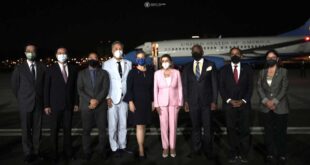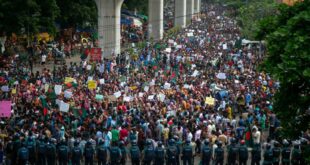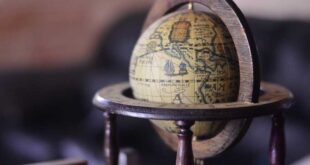Giancarlo Elia Valori
In my opinion, after the 19th CPC National Congress, two changes characterize the new form of Communist China: the amendment to the Party’s Constitution, with the phrase “Xi Jinping Thought on Socialism with Chinese Characteristics for a New Era” introduced directly by current President Xi Jinping. The other change is the new autonomous dimension of the Party’s ideology and hence of its practice.
This is the “miracle” promised to China by President Xi Jinping in his speech on the 40th anniversary of China’s Reforms started by Deng Xiaoping. A miracle that has in fact made China ready for a “new start”, while “the Party has strengthened China’s new pride” – after the mistakes of the “Cultural Revolution”, in particular – while the economic and social reforms could anyway lead to “sudden storms”.
Therefore China will not allow separatisms – “not even an inch of our Motherland can and will be separated from China”. Hence a hegemonic China, but “without seeking hegemony”.
The instrument to put an end to contemporary hegemonism, in a context in which President Xi Jinping uses again Mao Zedong’s “Three Worlds Theory”. The capitalistic and developed World, which includes the “two empires” – the two superpowers – and the two client States, and finally the Third World that will be led by China.
Hence China as owner of an economic development that “poses no threats to others”. On the contrary, and precisely for this reason – as President Xi Jinping maintains – “no one is currently in a position to dictate to China what should or should not be done in the world”. In its essence, this is exactly the “Socialism with Chinese Characteristics” that President Xi Jinping wants to reaffirm both nationally and internationally.
Again according to the current CPC’s tradition, the origin is to be found in Marx’, Engels’ and Lenin’s ideology, but above all within the project redeveloped by Mao Zedong, Jiang Zemin and Hu Jintao.
As can be seen, after Lenin the traditional sequence of Chinese points of reference for Marxism-Leninism was over. It continued with Mao and was later resumed – after the Four Modernizations – temporarily a few years ago.
Nothing has been decided yet. A Great Helmsman is still needed to guide, orient and direct the Socialist modernization of China.
Hence, there is no actual link between the Russian tradition of Communist revolution and the Chinese one.
This is also understandable: Russia wanted to follow the capitalist West so as to later destroy it – albeit it failed in this regard – while China was mainly concerned with the Third World, to which Communist Russia certainly did not belong. Later Russia accepted the Cold War, the useless “paper tiger”, in which China has never believed. Finally it imitated capitalism, without ever having a real potential to do so, while China was building its rational (and national) Socialism in rural areas, without imitating – at least after the Great Leap Forward from 1958 to 1961 – the European capitalist accumulation, nor the huge massacre of the Russian Bolsheviks’ crazy “rural reforms” between Crimea and Ukraine.
Hence, currently President Xi Jinping think that the result of implementing his Thought is the definitive “sinicization” of Socialism and the Party.
The effects of this new operational and political tradition by President Xi Jinping are seen – first and foremost – in the greater efficacy of the Chinese government.
President Xi Jinping’ Socialist government adapts to Chinese society – in view of transforming it – fitting like a glove on a hand.
The doctrinal and abstract tradition of Chinese Marxism-Leninism ended precisely with President Xi Jinping’s action. Currently the Chinese Nation and its historical project, namely Socialism, are the same thing.
Progress towards Socialism – now inherent in the fabric of the Party, of the State and of society – is the same as the peaceful and multilateral reaffirmation of the Chinese Nation as such.
Pragmatism, above all adherence to the reality of Chinese society, but together with a profound modernization of the system, of society and of the CPC itself.
Hence, President Xi thinks that there are currently four goals at reach. Firstly, Socialism with Chinese Characteristics that now, thanks to President Xi Jinping, is fully embedded in China. Secondly, the Party’s ideology, which is always falling within the State’s competence and is hence responsible for the Nation’s and People’s national evolution, but now merges national interest with Socialism. Thirdly, the reaffirmation of the Party’s role on the State, which may still be lagging behind President Xi Jinping’s project. Fourthly, the Party’s culture, which is the one and only guidance for the Party itself.
In other words, this means strengthening the Party’s culture to improve its role as an example, as policy line and as future direction.
According to President Xi Jinping, the Party’s primary goal for the whole Chinese Nation, and not only for its proletariat, is the improvement and, above all, the current consolidation of the People’s living conditions.
Wellbeing is one of the goals of “President Xi Jinping’s policy line” that dominates the Party, in addition to the gradual construction of a Great Country for everybody (no limitation to China’s military and strategic prestige) and a Strong Country (no limitation to Socialist China’s geopolitical projection). Also a Civil Country (no limitation to the people’s cultural and ideological evolution) shall be constructed and a Democratic Country (the maximum representation, within the Party, for all the voices of Chinese society), as well as a Harmonious Country, i.e. without the typical imbalance of society with respect to the evolution of its political direction. “Productive Forces” and “Relations of Production”, just to put it in Marxist terms.
Hence the Party dictates the policy line and the Chinese harmonious society adapts it to every condition and situation.
It is in this sense that today, under President Xi’s leadership, we can speak about a particular “China’s Renaissance”.
A mass Renaissance – just to recall Antonio Gramsci’s theories – that hence avoids the problem of being – like the Italian national Risorgimento – a “reform led by the elites alone” and limited in its scope and purposes.
Hence national and cultural mass renaissance, spread among all classes of the People, the Party and the Nation.
We should not believe that this historical phase is based on a limited, artificial or ad hoc memory.
As early as July 1921, when the Communist Party of China was established in Shanghai, the founding members included Li Dazhiao, the founder of the Research Association on Marxism.
From the beginning, there was an independent study on the dialectic of classes and on historical materialism, based on Chinese material conditions.
Hence the study was focused on the specificities of the possible Chinese Communist revolution, as well as on the autonomy of the national and social thought. Maximum attention was paid to the classics of Marxism, while the Russian Bolsheviks were still unable to define their own way, between global revolution in capitalist countries and what could already be perceived, namely “Socialism in one country”.
As early as August 1921, a few days after the Party’s foundation, Zhang Guotao established the Secretariat of Chinese Workers.
From the beginning – and this is a sign that persists and, indeed, is strengthening even today – the workers’ representation and the Party were almost the same organization that overlapped. It never happened in the history of any Communist Party.
Hence no Stalinist “transmission belt”: the trade union and the Party were both inside the Chinese society and transformed it every day, without the old-fashioned separation between “reforms” and / or “revolution” – the sign of a rough thought and, to many extents, not typical of Chinese wisdom, in which every change and every revolution are either large or small. It depends but, however, it is not a subjective evaluation.
Also the relationship between the newly founded Communism and the Chinese national movement strengthened from the beginning. There was not the long discussion between the national and progressive movement and the proletarian movement that was the basis for the evolution of the European, Western and Russian Communist debate.
Sun Yat-Sen’s Kuomintang immediately opened its doors to Chinese Communist trade unionists, who characterized the trade union movement far beyond the limits of their Party.
Another anomalous tradition of Chinese Marxism compared to the West, as well another root of the bond between the Party and the Masses, that President Xi Jinping still passionately emphasizes.
In 1922 Mao Zedong, Liu Shaoqi and Li Lisan organized trade unions and mass strikes, not only of the Communist workers – as in the West – but in the Hunan Province. Again in July 1922, the Chinese Communists decided to collaborate with the then progressive nationalism of Sun Yat Sen and the Kuomintang, even in opposition to Mao, who did not fully agree.
That choice was at the origin of both the CPC’s nationalist roots – without delays and rhetoric – and of certain ideological infiltrations that Mao Zedong tried to later use or eliminate.
A problem that President Xi Jinping has definitely solved.
A very severe problem, i.e. adapting without imitating and, hence, without absorbing the contradictions of Western capitalism, which is still in Xi Jinping’s mind.
Only in 1923 did the CPC and the CPSU sign a mutual collaboration agreement.
When, while referring to Russians, Deng Xiaoping spoke about the “enemies of the North”, he was still the spearhead of an old tradition of Chinese Communism.
In 1923, however, the CPC officially adopted the “Russian policy line”.
At the time, Mao Zedong joined the Central Committee and actively collaborated with the Kuomintang.
Nevertheless, the price paid by the Kuomintang was very high: in January 1924 the CPC became part of the Kuomintang itself, albeit with three clauses: the alliance with the USSR; the stable unity of action with the Communist Party; the equally stable mass action with peasants and workers.
Three factors that led to the end of Sun Yat Sen’s nationalist movement – except for new and powerful allies.
In that case there was no obvious “entryism”, as we say in the jargon of European Communism: in China, Mao’s CPC was a Party entrenched within the masses it stably represented and connected with what the Marxists – probably somehow naively – still defined “national bourgeoisie”.
As early as 1924, in Shanghai the CPC decided to step up “mass work”, while preserving its organization independent of the Kuomintang.
The national bourgeoisie and the so-called “compradora” bourgeoisie merged in China – and hence in the Kuomintang. Therefore the CPC needed to become autonomous and work with every part of the revolutionary bourgeoisie.
Unlike what happened in Europe during the same period, when the national Communist Party either stood as the enemy of everyone – and above all of the progressive bourgeoisie – or rendered itself useless by remaining in a sort of splendid and useful isolation.
Or it accepted unity with everyone, thus starting to lose itself and its political autonomy.
The Canton Merchants’ Corps Uprising of August 1924 – in which the merchants were supported by Great Britain – was initially a rebellion against a new tax imposed by the government, which everyone also considered an expression of the USSR.
The uprising was repressed, but the CPC’s struggle to avoid being identified as a simple offshoot of Russia was successful.
On that occasion, the Kuomintang’s Central Bank was created.
It happened in Canton, while, shortly afterwards, China found itself in four areas dominated by weak military coalitions.
That was the real and empirical connection of Socialism with national unity in China.
Without unity of the Chinese people – apart from the identities imposed by colonialism (and by some “friendly” country, currently as in the past) – there could be no unity of the nation and, hence, of Socialism itself which, if not led by the People’s Party of China, would inevitably repeat the “century of humiliation”.
Finally, in early May 1925, Mao Zedong was elected President of the rural federation, always under the then national and progressive aegis of the Kuomintang.
Hence without an analysis of the peasant conditions – which is not mere productive “backwardness”, according to the old Russian Bolsheviks – there is no Chinese Communism not referring directly to a specific and material analysis of the peasant conditions.
Hence we cannot reduce the peasant issue to a trivial theme – not by chance used both by the Russian Bolshevik Communists in their heinous “reforms” and by capitalists of the 1960s, the years of “take-off” and “underdevelopment”.
Rural areas were not tantamount to underdevelopment. They were tantamount to exploitation, if anything.
Without underdevelopment, what could we eat?
Hence, as already seen, the CPC was born within the union and realistic context of the protection of needs of a wide majority of people, mainly rural, while maintaining a sound political and ideological class identity – as is still the case today.
In 1928, Chiang Kai-Shek’s troops, the Kuomintang, occupied Peking.
In that year, again referring to the rural masses, the CPC ordered the “Autumn Harvest Uprising”, thus triggering and resolving the problem of the true origin of class struggle in China, i.e. the clash between poor peasants and landowners.
In 1929, the law confiscating the lands of Xing’guo and the new Civil Code were enacted. Hence the confiscation of State lands and of those belonging to landowners started.
The war against Japan, which had invaded Manchuria, began.
In February 1936, the Red Army marched towards Shiensi and recruited thousands of peasants, also with the support of the local warlord.
The CPC asked not to requisition the lands of those who had fought against Japan.
Nation and People, but also Socialist transformation of the economy. All three things together – as is currently the case.
After many acts of war, also the tragic Nanjing massacre took place.
A cruel slaughter of local inhabitants by Japan. 350,000 civilians were annihilated.
China’s main cities were conquered by Japan, which meanwhile had established the capital in Peking.
In 1943 the war was not over yet: the CPC adopted the so-called policy line of the “Resolution of the Many Traditional Problems”, under Mao’s direct supervision.
In 1945 Mao’s positions at the CPC Congress gained the upper hand in Ya’an – hence the policy line of the coalition government.
Therefore the CPC’s essential political issue was solved, i.d. the national bourgeoisie that had become part of the Party. Also the social issue was solved, with the autonomous leadership of the CPC, which dealt with the great agrarian reform. There was also the military and strategic issue that, at the time, was already outside the CPSU scope. Finally uniqueness of power after the evident defeat of the Kuomintang.
Almost the same as today.
In 1948, the Chinese People’s Bank was established as issuing bank.
In particular, it guaranteed the funds necessary for the companies to reach the goals of the five-year plan.
Autonomy from the global financial cycle, when needed – as is currently the case.
In 1949 the Red Army returned to the liberated city of Shanghai.
What about the Belt and Road Initiative? Today’s Long March? What role does it currently play?
It is largely a legacy of Hu Jintao and of the solution of the Chinese border issue by Jiang Zemin.
At predictive level, it is a matter of 65 countries with a maximum trade totalling 2.5 trillion US dollars over ten years, with a project like this one that is expected to amount to 26% of the current Chinese foreign trade.
An opportunity to find a way out, to remove dangerous land borders and to finally put an end to China’s estrangement from contemporary world.
Not a “Cold War”, but a gradual multilateral and bilateral integration.
Hence making the energy supply safe for China with the Belt and Road Initiative, as well as getting out of the spiral between monetary QE and commercial expansion, only thanks to the huge dimension of the Belt and Road Initiative, and finally finding an outlet for foreign direct investment that China desperately needs.
A current sum of factors responding to the three policy lines with which the Party was founded: national interest at first, unity of the Nation and economic development.
Honorable de l’Académie des Sciences de l’Institut de France
President of International World Group
 Geostrategic Media Political Commentary, Analysis, Security, Defense
Geostrategic Media Political Commentary, Analysis, Security, Defense





